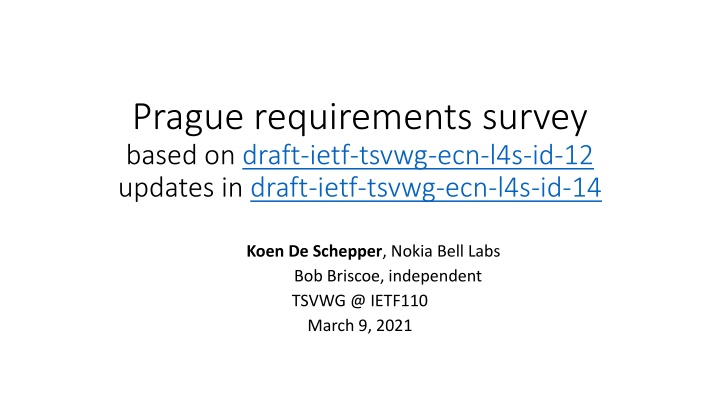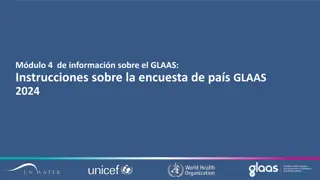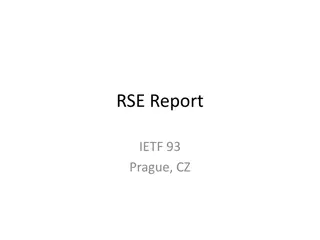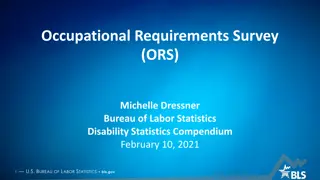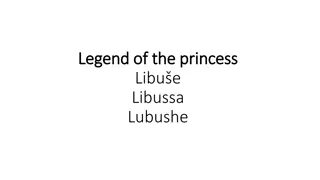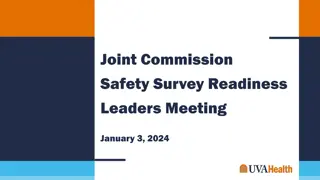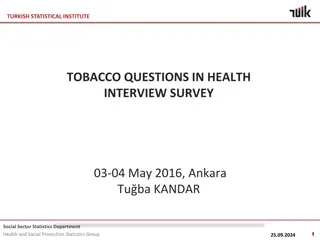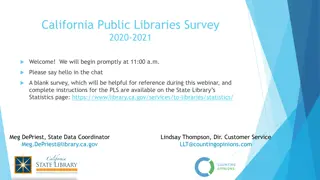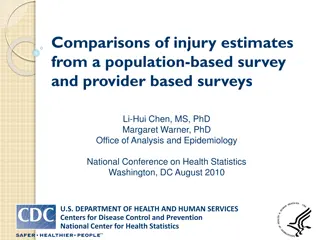Prague Requirements Survey Updates
Survey on Prague requirements based on draft updates by Koen De Schepper and Bob Briscoe, targeting CC developers supporting L4S. Responses from multiple sources are shared publicly and privately, with compliance analysis and planned actions on the draft.
Download Presentation

Please find below an Image/Link to download the presentation.
The content on the website is provided AS IS for your information and personal use only. It may not be sold, licensed, or shared on other websites without obtaining consent from the author.If you encounter any issues during the download, it is possible that the publisher has removed the file from their server.
You are allowed to download the files provided on this website for personal or commercial use, subject to the condition that they are used lawfully. All files are the property of their respective owners.
The content on the website is provided AS IS for your information and personal use only. It may not be sold, licensed, or shared on other websites without obtaining consent from the author.
E N D
Presentation Transcript
Prague requirements survey based on draft-ietf-tsvwg-ecn-l4s-id-12 updates in draft-ietf-tsvwg-ecn-l4s-id-14 Koen De Schepper, Nokia Bell Labs Bob Briscoe, independent TSVWG @ IETF110 March 9, 2021
Survey for Prague Congestion Controls Goal: are Prague requirements feasible/realizable and supported by a broad community (allows several different CCs)? Template provided: List of all normative requirements List of 3 performance improvement suggestions (no normative text) Targeting Congestion Control developers having a Prague CC, or that plan to support L4S using the L4S-ID ECT(1) 2 questions asked: Compliant / Partially Compliant / Non-compliant Any description/limitations/remarks/explanation related to evaluation, implementation and plans (will implement or will not implement) can be explained here. Any expected or experienced issues and any objections/disagreements to the requirement can be explained and colored appropriately here. Explain at what level you (plan to) meet the requirement
Multiple responses received 3 were publicly shared: Linux TCP-Prague by L4Steam SCReAM by Ingemar Johansson GeforceNow by NVIDIA Listed in https://l4steam.github.io/#prague-requirements-compliance Other responses shared privately: consolidated summary available at: https://l4steam.github.io/PragueReqs/Prague_requirements_consolidated.pdf
Compliant/supported or planned by all Requirements: An L4S sender MUST set the ECN field to ECT(1) OS APIs and Kernels need to support it MUST NOT set ECT(1) unless it complies with A sender that sets ECT(1) SHOULD implement a scalable congestion control MUST provide feedback of the extent of CE marking Some remaining concerns with Accurate ECN tcpm MUST reduce RTT bias Also, more throughput is planned for longer RTTs SHOULD detect loss by counting in time-based units Non-Normative performance suggestions: Setting ECT(1) in TCP Control Packets and Retransmissions Faster than Additive Increase Faster Convergence at Flow Start Actions on the draft: OK after minor clarifications
Strong objections on documentation-only reqs The specification MUST describe in detail The specification MUST define, quantify and justify burst limit approach - Are these documentation requirement really needed? - How can it be enforced? - May not be possible (proprietary). Actions on the draft: These requirements have been removed
Needs experimental data SHOULD scale down to fractional congestion window - Not all convinced if it will be a problem on the Internet, and might not implement - Multiple research implementations exist; others support it or plan to implement Not a safety issue, but would prevent extra latency on L4S-only queues and drop on Coupled-AQMs Propose: Keep SHOULD. Develop further during experiment as needed. Actions on the draft: Updated based on discussions on the mailing list (further refinement/clarifications)
Needs experimental data MUST implement monitoring to detect non_L4S ECN AQM - Is detection itself required? - Robust detection scheme needs real deployment experience. - Combination with delay-based control could minimize potential issues - Develop during experiment as needed. SHOULD be capable to automatically fall back MUST be capable of being replaced (operator action) by a Classic congestion control - Is replace required or can it disable L4S part to reduce to Classic response only - On active flows or new flows If L4S Operational guidelines draft is adopted, these requirements will need to be aligned with it. Actions on the draft: Todo: further refinement/clarifications
Compliant (to intent) by all: Needs Clarification MUST react to packet loss in a way that will coexist safely with a TCP Reno congestion control [RFC5681] - Not clear what it means "coexist safely with a TCP Reno congestion control - Don't want to be as degraded as Reno for long RTTs Seeking input from WG on correct wording for this requirement e.g. RFC5033 Discussion started on the mailing list Balance between openness to innovations and guidance/recommendations keep open during experiment, not the mechanism but the result is important Practical example in TCP-Prague CC draft
Conclusion Strong objections against MUST document all removed Develop during experiment to determine need and get real live data: Scaling down to fractional windows Classic ECN bottleneck detection align with L4S-ops if adopted Others already have implementations, or req s are seen as feasible and are planned to be implemented Other inputs are still welcome (public or private)
All agreed: Compliant or planned An L4S sender MUST set the ECN field to ECT(1) - Compliant or planned - OS APIs and Kernels need to support it (can RFC8311 be used to justify API updates) - Compliant or planned - More clarification needed to align marking rate to throughput None, OK as is A sender that sets ECT(1) SHOULD implement a scalable congestion control Improve informative text for rate convergence of long flows MUST eliminate RTT - Compliant or planned - Also for longer RTTs more throughput is planned - Compliant or planned None, OK as is SHOULD detect loss by counting in time-based units None, OK as is MUST NOT set ECT(1) unless it complies with following - Compliant to this requirement None, OK as is - Comments were on referred requirements
All agreed (non-normative): Supported or planned Setting ECT(1) in TCP Control Packets and Retransmissions - Supported or planned RTP/RTCP clarifications will be added Faster than Additive Increase - Supported or planned None, OK as is Faster Convergence at Flow Start - Research code exists and planned None, OK as is
Questioned and Strong objections The specification MUST describe in detail - Is this requirement really needed? - How can it be enforced? - May not be possible (propriatary). - Multiple research codes exist - Not all convinced if this is needed, others support it and plan to implement - Develop during experiment as needed. This requirement is removed SHOULD scale down to fractional congestion window Keep SHOULD. The need for this requirement should be observed during the experiment limit bursts The specification MUST define, quantify and justify its approach - Normative requirement is mainly documentation related, see above - Can more clear guidelines be given? The normative MUST is removed. Warning text still present.
Clarification needed MUST provide feedback of the extent of CE marking - Compliant - Clarification needed for feedback timing and RTT requirements - Some remaining concerns with Accuate ECN - Appropriate feedback timing depends on the proprietary protocol and needs to be tuned to it - Remaining concerns about Accurate ECN needs to be dealt with in tcpm. - Seeking input from WG on clarification to this requirement e.g. RFC5033 MUST react to packet loss in a way that will coexist safely with a TCP Reno congestion control [RFC5681] - Compliant to the intent - Not clear what it means "coexist safely with a TCP Reno congestion control" - Don't want to be as degraded as Reno for long RTTs - Robust detection scheme needs real deployment experience. - Develop during experiment as needed. - Combination with delay-based control could minimize potential issues - Clarification: is detection itself required? MUST implement monitoring to detect non_L4S ECN AQM SHOULD be capable to automatically fall back MUST be capable of being replaced by a Classic congestion control - If L4S Operational guidelines draft is adopted, these requirements will need to be aligned with it
